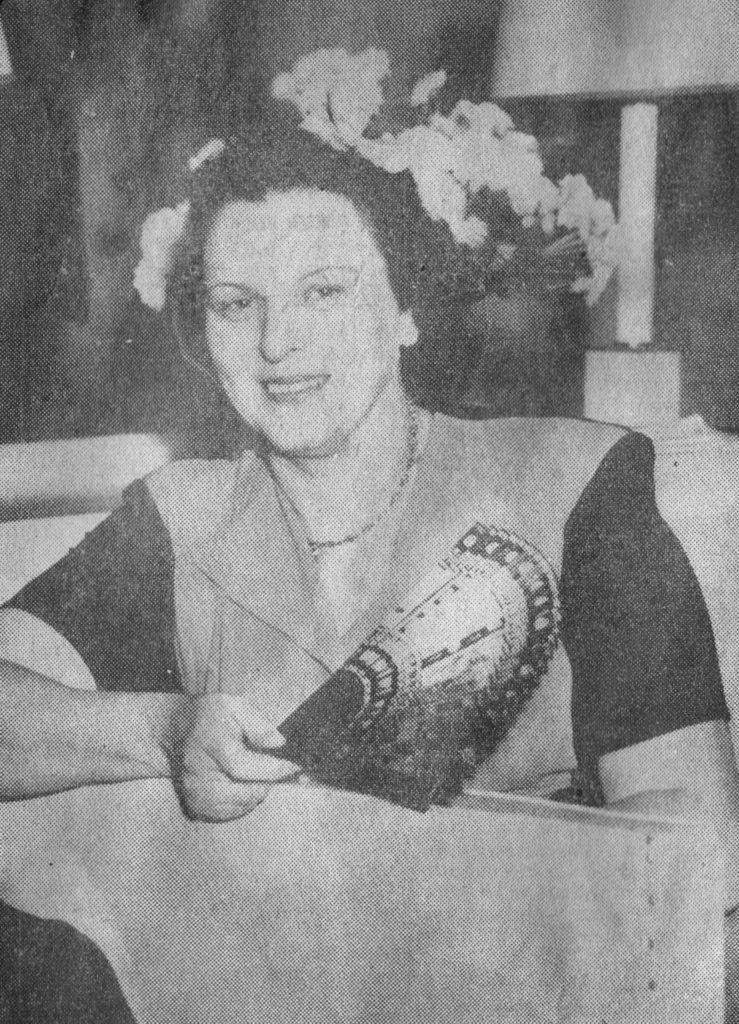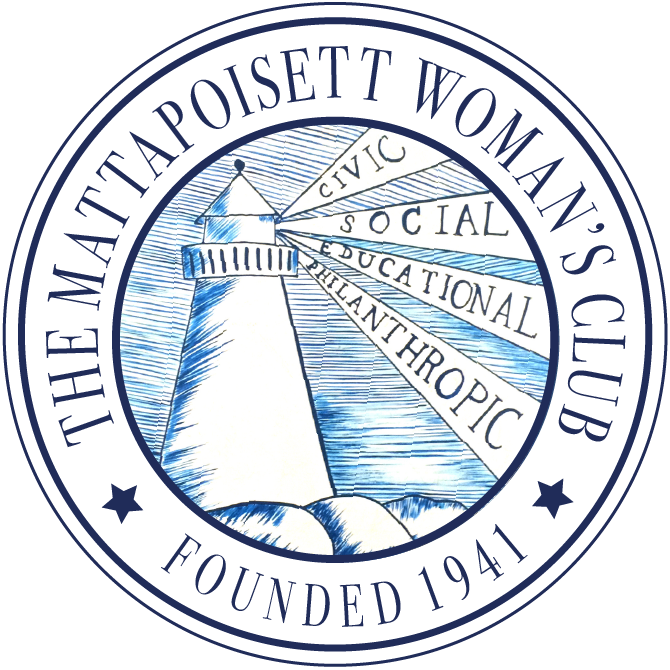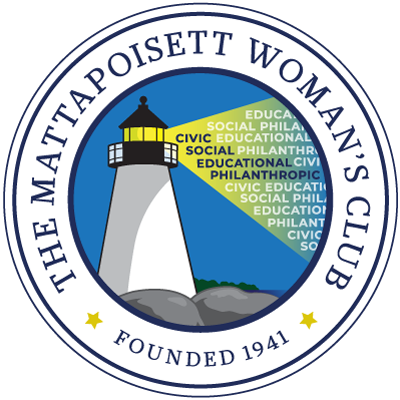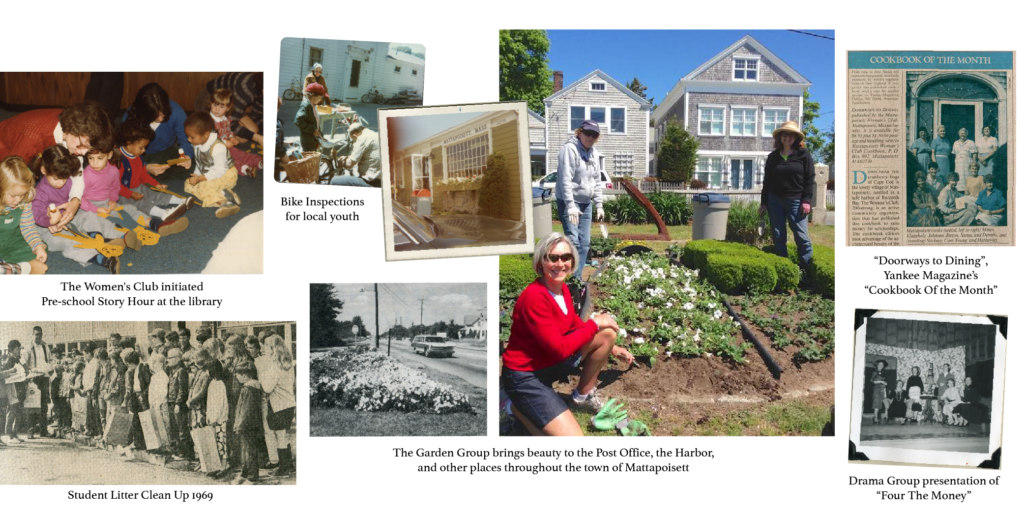The History of the Mattapoisett Woman’s Club
The Mattapoisett Woman’s Club was organized in the fall of 1941. Mrs. Paul Keller (Zita) was the first president; and the first organizational meeting was held on October 21 at her home on North Street. A committee on by-laws and a nominating committee were established. The next meeting was set for Monday, October 27 at the Town Hall. Seventy women signed the original charter; the charter was held open until December 8, 1945. At that time there were 85 members. Dues were $1.25 a year and an initiation fee of 50 cents was set for new (not charter) members.
Zita Keller contacted key women in the Massachusetts Federation of Women’s Clubs. Representatives from the Federation visited the club to tell members what the Federation could offer them and what the club could give to their organization, should they join. At the mid-winter meeting on February 19, 1942 at the Bradford Hotel in Boston, the Mattapoisett Woman’s Club welcomed as a member of the Massachusetts State Federation of Women’s Clubs. The club became a member of General Federation of Women’s Clubs in 1951.
The club appointed the officers and board of directors and they meet on the third Thursday of the month either at the Town Hall or the Grange.



The Mattapoisett Woman’s Club logo was designed in 1969 to best reflect the purpose and goals of the club. The lighthouse represents leadership. The stone base represents the various interest groups within the club that support our members. The rays of light beaming from the lighthouse signify the strength of light that will shine, depending on the enthusiasm and hard work of club members.
From the beginning, the Club’s objectives were civic, social, educational and philanthropic. In 1969, the Mattapoisett Woman’s Club’s logo was designed to best reflect the purpose and goals of the club: The lighthouse represents leadership; the stone base represents the various interest groups within the club that support our members; and the rays of light beaming from the lighthouse signify the strength of light that will shine, depending on the enthusiasm and hard work of club members. These objectives remain the core of our club today.
Although the club formed in the fall of 1941, it quickly took on many new responsibilities and concerns just a few months later, with the bombing of Pearl Harbor on December 7th. As U.S. Armed Forces joined the rest of the world in World War 11, priorities quickly shifted to focus on the war effort. Throughout the war years of the 1940’s the Mattapoisett Woman’s Club was involved in providing monetary funds and material gifts to military camp, hospitals, and veterans’ organizations as well as the Red Cross. Members volunteered many hours assisting in care, reading, and writing letters for the patients. The club purchased $1200.00 worth of War Bonds and donated to many relief funds around the world. Despite the war, the club’s groups thrived. The drama group presented skits; the music group held educational and entertainment programs; the garden group held plant sales; and the handicraft group held exhibits and sales of their wares. Dances were held to raise money for adoptions centers and other similar organizations. Similar efforts were made by the Club during the Korean, Vietnam, and Persian Gulf Wars.

In 1943 the Club donated its first scholarship of $5.00 to a graduating student from Center School and in 1944 two scholarships to junior high graduates: $3.00 to the top academically scoring student and $2.00 to the second highest scoring student. By 1945 the Club offered a certificate of honor to each of the highest ranking honor students in Center School and a $50.00 scholarship to a Mattapoisett student graduating from high school.
Since its founding in 1941, the Club and its members have completed hundreds of hours of volunteer work and have contributed monetary support for the needs of Mattapoisett, surrounding communities, and around the world. Club members were very resourceful in fundraising activities to benefit the club’s civic and philanthropic endeavors, especially scholarships. They held numerous balls and dances with a variety of dinner themes such as the Silver Gull Ball, Poverty Ball, an Evening in Sorrento, The Bicentennial Heritage New Year’s Eve Ball, and a Cafe’ Musical with singing waiters. One particularly popular club activity was the drama group that presented many plays and skits; their own version of the Gong Show; auctions; house tours; and garden tours. The group also published a cookbook, Doorways to dining, which was featured in Yankee Magazine as “Cookbook Of the Month. Today, the Club’s Taste of the Town and its biennial Garden Tour are its biggest fundraisers.
Over the years, the Club donated approximately $100,000 in scholarships and has supported town improvement projects such as Shipyard Park’s bandstand, benches, and picnic benches, The town’s recent library addition and wall-to-wall carpeting for Old Hammondtown School’s ;library are among the many town improvement to which the Club has contributed. The Club also sponsored many education programs for the community, among them h as Candidates’ Night, the Get-Out-the-Vote effort, the bicycle safety; anti-littering; recycling; Saturday story hours at the Public library; school and public music programs; and the creation of the bike path to name just a few. Today, the Club supports a strong scholarship program that procures the funds for and then awards two scholarships to graduating high school seniors from Mattapoisett and one scholarship to a continuing education student, also from Mattapoisett, who wants to move ahead in their career path through additional educational endeavors; volunteering; and securing monetary and material support to the community.
In the Club’s history, its membership started with 85 women and went as high as 224 members at its peak. .In recent years, membership averaged at just over 100 members. Some of the social groups that have existed within the Club over the last 80-some years have included: bowling; garden study and implementation; bridge;, the chorale; literature discussions; fine arts appreciation; American home exploration; gardens and conservation; “soapbox” discussions, gourmet cooking; music; drama; international relations; Great Decisions; finances; defense; and Readers Digest appreciation. Some of these original groups have survived over the years, depending on the interests of the members at any given time.
It is surely apparent to the reader that the civic, social, educational, and philanthropic rays coming from the lighthouse on the Club’s lighthouse are intertwined. One ray cannot succeed without the other. When the Club was first organized, the rays were the original focus of its members. Those four rays continue to burn as brightly today because of the enthusiasm and hard work of its members.
